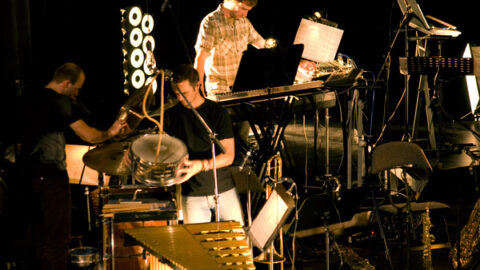 Hailing from The Hague, Ensemble Klang brought its unique blend of sounds and grooves to Symphony Space in NYC on Wednesday, Oct. 19th as part of the Sonic Festival. Consisting of 2 saxophones, trombone, piano, percussion, guitar, and electronics, Ensemble Klang draws from a rich sonic pallet that includes elements of European jazz big band, minimalist contemporary ensemble, industrial rock band, and lots of originality. While the music they played was full of exploration, nothing felt overdone – the pieces were presented with tightness, feeling, and rhythmic excitement. At times it was hard to sit still – out of feeling the intense yet controlled energy coming from the stage.
Hailing from The Hague, Ensemble Klang brought its unique blend of sounds and grooves to Symphony Space in NYC on Wednesday, Oct. 19th as part of the Sonic Festival. Consisting of 2 saxophones, trombone, piano, percussion, guitar, and electronics, Ensemble Klang draws from a rich sonic pallet that includes elements of European jazz big band, minimalist contemporary ensemble, industrial rock band, and lots of originality. While the music they played was full of exploration, nothing felt overdone – the pieces were presented with tightness, feeling, and rhythmic excitement. At times it was hard to sit still – out of feeling the intense yet controlled energy coming from the stage.

The highlight of the concert for me was a piece titled 101 by Kate Moore. A spooky groove between piano and vibraphone together with a half-step motive in the winds spiraled into something trance-like yet bursting with energy. The texture Moore created was both intricate and filled with punctuation. I came to this concert right after an afro-beat band rehearsal, and I was much impressed with how in 101 larger accent patterns emerged from the busy motion of the ensemble. This was not complexity for its own sake, but a well designed musical tapestry in which the sum was greater than the total of its parts. Moore knew just how to utilize the strengths of Ensemble Klang – making use of the winds’ ability for such a variety of articulations as well as rapid and wide-ranging changes in dynamics. Electric bass was also a great fit for this piece, and the heavy grooves it emanated reminded me of 90s Cleveland industrial band Filter. The bottom line is I really felt the groove and pulsation with this one, but I’m not sure a seated crowd on upper west side NYC could handle this much musical energy.
While 101 was a jam like rush hour traffic, Oscar Bettison’s o death went the furthest in pulling out every sound possible from the ensemble. The saxophones pulled out all the stops, from sonorous multi-phonics, using the keys like percussion, blowing into the instruments for a wind sound rather than actual pitches, and a great moment of two soprano saxes ringing out longer notes in the upper register and even smoothly bending pitches with finesse. While I am usually skeptical of large percussion rigs, each instrument seemed to fit perfectly into the sound world created and make for just the right blend with the rest of the ensemble. An almost industrial groove broke out at one point with the pianist holding the strings and hammering away on a low pitch and guitar rocking out – tastefully. Banjo, jaw harp, and high-pitched recorders more fit for canine ears added to the tour of sounds. Bettison knew just how to get the right blend at each moment. The alternation between sections of punctuated grooves and times where sounds just rang out made the lengthy piece stay fresh throughout.
A few words are in order here about the unique sound of Ensemble Klang. As a wind player, I was particularly impressed with the way the saxophones and trombone could create walls of pure sound, punches of volume and intensity, wave-like motion, and jittery yet smooth moving passages, all as part of an overall texture and with much attention to blending with the ensemble as a whole. Similar things could be said about the rest of the ensemble, though my ears tended to fixate on the winds, and the hall led to an imbalance in the sound, with the piano at times barely audible, and the guitar and percussion not ringing out in the same way as the winds. Despite the acoustics (and lack of a mic on the piano), I was impressed with the blend of the ensemble as a whole and every member’s contributions to the soundscape.

Sean Friar’s Little Green Pop was particularly impressive at drawing out the capacity of the ensemble to blend. The soprano sax was bright but at the same time round at the edges. The tenor sax and trombone provided a warmth that softened the sound. And the vibraphone provided a certain celestial quality. The accents in this piece felt a bit more like springtime bursting out, and when it broke into more of a groove it was more one of upbeat minimalism rather than the ominous quality of the previously described pieces.
Pete Harden’s forming a petal from a piece of metal was similar in the way the sounds sat there for your ears to take in. The piece had an ethereal quality without ever getting brash. Given my lack of sleep the previous night (and numerous hours in my lifetime spent listening to hardcore punk and east coast rap), I was more attracted to the heavier groove-oriented pieces, but the textures and open sonorities created by Harden’s piece were the right thing for a more relaxed state of mind.
My only criticism of the concert as a whole was that the selections were too oriented towards sound textures, without much in the way of prolonged melodies. This is not too say the music was lacking in excitement, just that a bit more variety in the program could give it more appeal. But speaking of appeal, it struck me that Ensemble Klang could likely engage audiences who have never been exposed to this sort of music. Nothing felt overdone, and the music was overall full of clarity, energy, and rhythms that you could really feel. In this regard, Ensemble Klang was an excellent choice for Sonic Festival’s intent of presenting 21st century music to the public. This is the kind of experimentation that can really generate enthusiasm for new art music.
–
David Pearson is a saxophonist residing in NYC.
























